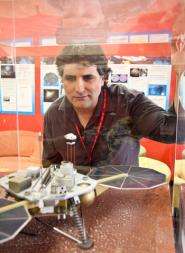UA eyes $30 million Google Lunar X prize

In the second article [first story] about the research of UA space systems engineer Roberto Furfaro, we look at his work with Moon Express, a privately funded lunar transportation company that plans a pinpoint landing on the moon in 2014, giving it a good chance of winning the $30 million Google Lunar X Prize.
University of Arizona engineer Roberto Furfaro and the Moon Express team have ripped a page from science fiction with plans for a pinpoint-accurate landing on the moon.
While sci-fi spacecraft touch down with helicopter-like aplomb, the past 50 years of real-world exploration haven't been nearly as precise.
The Phoenix Mars lander, which parachuted into the Martian atmosphere in May 2008, was aiming at a swath of country 120 kilometers long by 20 kilometers wide. The early Apollo missions of the 1970's, even with human pilots, aimed for real estate 3 kilometers long and half a kilometer wide.
When the autonomous guidance system Furfaro and his colleagues are developing flies the privately funded Moon Express lander to the lunar surface in 2014, it will touch down to within 10 meters of its target, and may simultaneously capture the Google Lunar X Prize.
The $30 million X Prize will go to the first privately funded group to land a spacecraft on the moon and deploy a robot, which must travel 500 meters and send back an image and data to Earth.
Furfaro, an assistant professor in the UA systems and industrial engineering department, calls this kind of rocket-assisted soft landing a "very difficult and exciting project."
Tom Gardner, chief engineer at Moon Express said Roberto's guidance algorithm will take over with three minutes to go before landing.
"There is a big rocket burn that slows us way down to about 50 or 60 miles per hour," Gardner said. "His guidance takes over and that's at about three miles above the surface. It takes us from there to a very precise point on the surface."
No extraterrestrial landing has ever approached this kind of accuracy.
Why now?
"I think part of it is that we can take more risks as a private company," Gardner said. "We have investors who have confidence that we know how to do this."
Also, guidance technology has evolved dramatically since the Apollo era.
"Basically, landing on the moon is similar to a missile hitting a target," Gardner said. "You have to make a lot of quick decisions and you have to have a lot of agility to hit the target precisely. The only difference is we're trying to hit it at zero velocity instead of high speed."
He said three things are needed to make this happen.
First, the right guidance/approach software.
This is being developed by the Moon Express GNC guidance, navigation and control team led by Ian Garcia.
Furfaro is part of this team, as is one of his students, Dan Wibben. Eleanor Crane, a doctoral candidate at Stanford University, and Gardner also are team members.
In addition to his work on guidance systems, Wibben, a UA systems engineering master's student, has been working on trajectory analysis, communications, solar power systems and other parts of the lander project as a Moon Express intern this summer. "He's been a big help to us," Gardner said.
Secondly, sensors that "see" the terrain and tell the spacecraft computer exactly where it is with only milliseconds delay.
This is terrain-based navigation similar to the kind found on cruise missiles.
And third in the list: A high-thrust rocket engine that has plenty of reserve power to execute very short, high-thrust steering pulses.
"In the Apollo era or even in the Phoenix project, you could know you were off course, but there was nothing you could do about it," Gardner said.
"Because all your energy was going into slowing you down and actually landing," Gardner also noted. "In our case, we have excess thrust capacity to help steer to a precision target."
Another important factor is that the Moon Express team knows the terrain.
The Lunar Reconnaissance Orbiter Camera, developed by Mark Robinson of Arizona State University's School of Earth & Space Exploration is sending back images of the moon's southern polar region that have quarter-meter resolution.
Gardner said: "These images will allow us to land in an area where we have confidence that we're not going to break the spacecraft."
The X Prize is only the short-term goal at Moon Express, Gardner noted.
The company plans to become a major mining and transportation service, shuttling resources to and from the moon. This could include bringing valuable minerals, such as platinum and helium-3, back to Earth.
Team registration for the X Prize competition closed at the end of 2010. According to the X Prize website, 28 teams around the world are fundraising, mission planning and building robots in a new race to the Moon. Teams have until the end of 2015 to get to the Moon, meet the prize objectives and win the prize purses.
To become the lunar equivalent of UPS or Federal Express, precision landings, sometimes in areas that are less lander-friendly than the one Moon Express will use in 2014, will require reliable autonomous GNC systems that have built-in hazard-avoidance capabilities, Gardner noted.
That's a good reason to start clipping those pages from science fiction right now.
More information: moonexpress.com/
Provided by University of Arizona


















